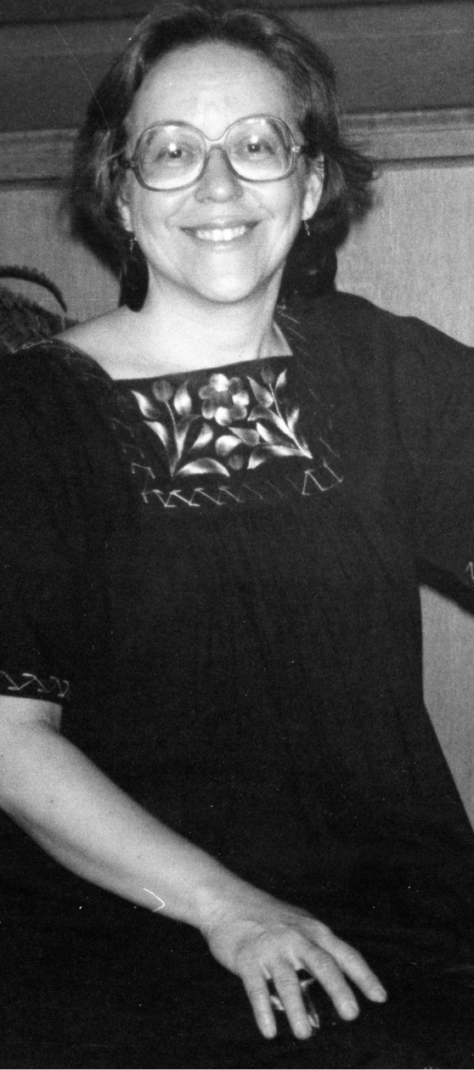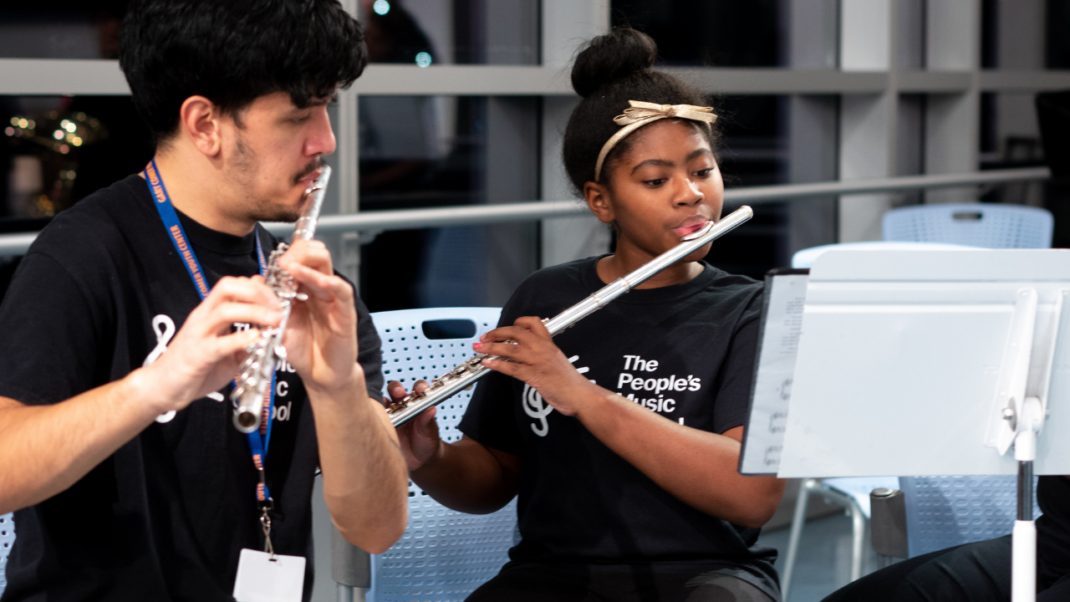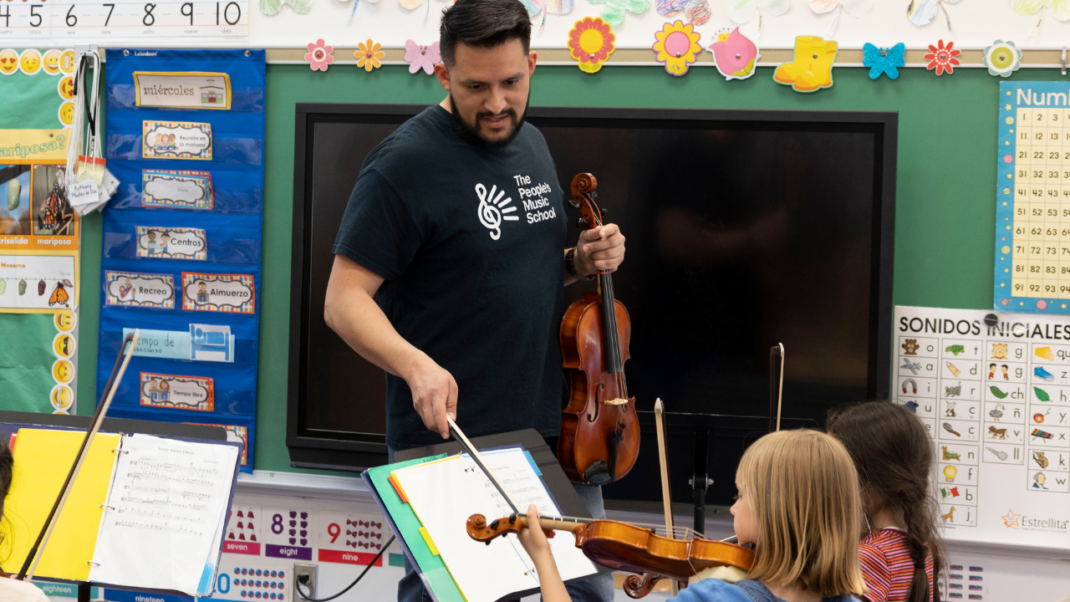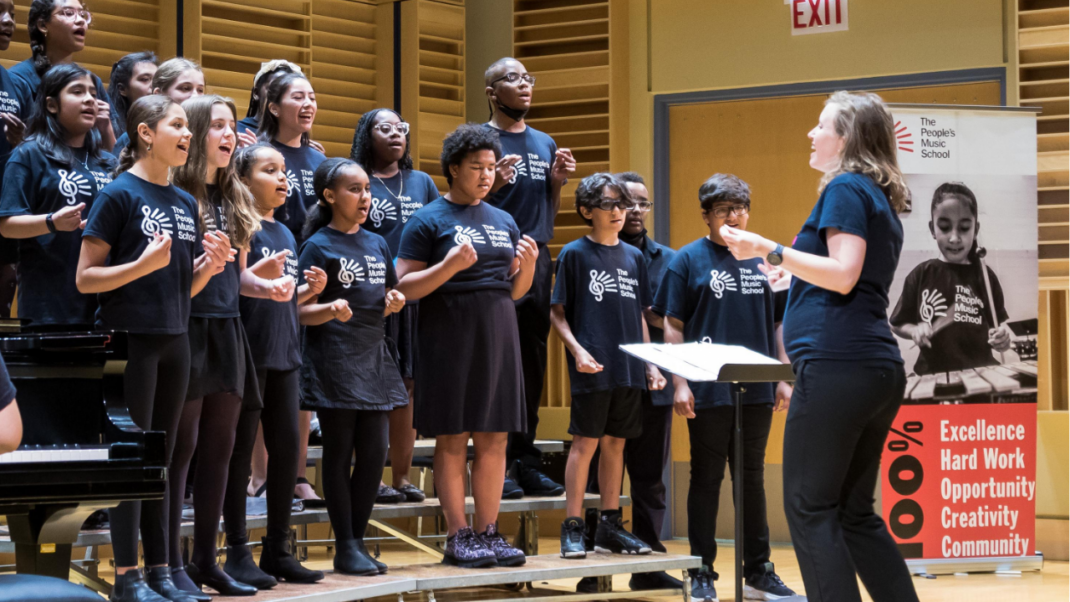

Intro
In February 1976, Dr. Rita Simó hung a handmade wooden sign in the front window of an abandoned hair salon: “Free music lessons.” Dr. Simó was a Juilliard-trained classical pianist who was inspired by the free music education she received as a child in the Dominican Republic. She had $625, a donated piano, and a vision to provide free music lessons to students in the Uptown community of Chicago. What started as a storefront piano studio and a radical dream has evolved nearly fifty years later into a community institution that has transformed the lives of thousands of Chicago students through access to free intensive music instruction.
The People’s Music School’s (TPMS) mission is simple yet profound: provide free, intensive music education to those who otherwise would not have access. The social, emotional, and academic benefits of music education should be a fundamental right of students, and TPMS works to make it available to students who would otherwise face financial barriers. The journey of TPMS from its humble beginning to a Chicago force is a roadmap and model for how cities across the country can transform students’ lives at scale through music mentorship.
The People's Music School Model and Impact
TPMS’s model has evolved over decades to provide music mentorship for children living in Chicago’s underserved communities, using a distinctive combination of depth, rigor, and community engagement. Its instructional model, as well as the infrastructure to implement this system, reflects nearly 50 years of TPMS’s active involvement in music education and curriculum development.
Through years of consistent growth, TPMS now provides intensive, after-school music instruction to over 700 students in grades 1-12 across four program sites in Chicago’s historically underserved communities. TPMS’s oldest program site operates out of its headquarter building in Chicago’s Uptown community, where it currently serves 300 students. TPMS’s other three sites are located on public school campuses, where TPMS partners with schools to repurpose underutilized spaces for afterschool programming for over 400 additional students. These sites are strategically co-located on Chicago Public Schools (CPS) campuses in some of Chicago’s most historically underserved communities (Back of the Yards, Bronzeville, and Albany Park).
Students who persist in TPMS’s program graduate high school and go on to attend college nearly 100% of the time. Even students who stay with TPMS for shorter durations see dramatic increases in school engagement, persistence, and grit. In fact, TPMS participated in a national study that found students participating in its intensive community music programs reported significantly higher levels of overall growth mindset than their peers, leading to a greater propensity to persist and adapt in the face of a challenge.¹
Underlying this work is significant field research backing the impact intensive music instruction has on students from marginalized communities. Research highlights that implementation of music-based instruction in underserved communities improves language-related brain function, leading to significant academic gains for participants.² Intensive after-school music training has been directly correlated with enhanced literacy and learning skills for students attending an under-resourced elementary school, with participants outpacing their peers on reading and literacy performance.³
TPMS’s programming at each site prioritizes five core components to maximize impact:
- No cost to participants. Equitable access is core to TPMS’s mission. TPMS does not charge students or families anything for its program and provides students with everything they need to access comprehensive musical instruction, including free high-quality instruments. All funds to support programming and operations are raised philanthropically.
- Intensive programming. Most students participate in the program for four hours per week of instruction, and they are assessed annually on their progress and social-emotional growth. Programming includes private and small group instruction across 21 instruments, music theory lessons, and performance in an ensemble. TPMS also amplifies its impact through community and artistic partnerships. Students gain access to master classes with local and national musicians, free access to city-wide performances, and opportunities to continue learning at summer programs across the country. All students also partake in performances multiple times throughout the year, often in front of a crowd of hundreds of parents, building their skills around preparation, mastery and confidence in front of an audience.
- Excellent faculty. TPMS prioritizes hiring, developing, and retaining highly effective music instructors that reflect the community they serve. TPMS’s faculty receive professional development, 1:1 coaching, as well as training on trauma-informed instruction and curriculum implementation.
- Culturally responsive curriculum. TPMS’s curriculum is designed by faculty and responsive to students’ needs. It is the culmination of nearly 50 years of doing the work in the community, and is designed to be culturally responsive and reflect the community TPMS serves. As an example, faculty have the expectation that at least 50% of the music repertoire taught to students is composed by BIPOC composers and incorporates non-Western music styles.
- Family empowerment and engagement. Families are partners in the work, and TPMS seeks to empower them to support students and the broader organization. All families are required to contribute at least 4 hours per semester of volunteer time, which cultivates families’ ownership of the program and their student’s progress. Families are also engaged through training, on-site opportunities, and feedback surveys. The result is families feel empowered and bought into the program. Every TPMS student performance is well-attended by family and community members, whether an individual recital or TPMS’ annual end of year performance that routinely attracts hundreds of families from across Chicago.

Journey from Storefront Studio to City-Wide Force
TPMS’s community site model has evolved significantly since its founding, driven by active involvement from local philanthropic organizations, meaningful community engagement, and a commitment to school-based partnerships.
1. Expansion into school-based partnerships
From 1976 until 2008, TPMS operated as a small, community music school in Chicago’s Uptown neighborhood. However, in 2008, an opportunity arose to address burgeoning demand in Albany Park, a neighborhood a few miles due west of Uptown. Inspired by the immersive music education model pioneered by Venezuela’s El Sistema programs⁴, TPMS sought collaboration with a local partner school to host the program. Leveraging preexisting relationships with administrators from Hibbard Elementary School, TPMS rallied support from funders and the school community to design a program tailored to the needs of Hibbard Elementary’s school community. A pivotal feature of this initiative was providing immersive music instruction directly at the school site in an afterschool context. What began in 2008 as a satellite afterschool program catering to 30 students has since grown to serve over 130 students annually.
2. Cultivating “anchor partners” to expand school-based approach
In 2016, TPMS was approached by another community arts organization with a proposal for TPMS to take over management of a small music education program in the Back of the Yards community. This community arts organization’s primary focus was performance, and its minimal experience in the arts education space limited its ability operationally and financially to grow the program. The parties partnered with a private foundation to obtain the funds needed to scale and grow the program, and capitalizing on its network within the community and its existing ties with CPS, TPMS secured a partnership with Agustin Lara Academy to serve as the host site for the program. This allowed the program to be integrated onto a school site, creating the foundation for future growth and partnerships in the community. Echoing the approach taken in Albany Park, this program prioritized the delivery of tailored music programming to students attending Agustin Lara Academy and neighboring elementary schools, thereby reinforcing its commitment to eliminating barriers to access.
3. Maturing the instructional model
As TPMS grew its geographic reach, its instructional model matured. In 2016, the school added a new role, Dean of Learning and Teaching, whose primary responsibility was to generate the school’s first comprehensive curriculum aligned to national standards. This initial curriculum included a sequential curriculum for 17 instruments and music theory. In 2020 a dedicated Learning and Teaching team was created, which spent a period of 18 months meeting with teaching artists to help them refine and expand the curriculum. The current curriculum includes a 10-level, standards-aligned curriculum across all 21 instruments as well as music theory/composition, General Music, improvisation, and repertoire guidelines, all of which are aligned to National Core Arts Standards. This curriculum now underlies a common calendar of student assessments, including an annual performance jury, theory examinations, and composition projects for all students, whether they are 6 or 16 years old. The school matured its approach to management of faculty talent, including providing 15-20 hours of professional development annually and adding regular faculty observation and feedback. This infrastructure has become essential to maintaining programmatic quality across all four unique sites.
4. Increasing access through community hubs
As TPMS looks to the future, its approach remains steadfast – evolve the model to continue bringing the program to where students are in order to reduce barriers to access and reach students who otherwise would not be able to participate. Significant unmet demand persists across the City, and TPMS’s strategy moving forward is to develop more hubs of neighborhood music programming.
TPMS’s program site on the South Side of Chicago is a prime example of this approach. Located at Wendell Phillips Academy High School in the heart of historic Bronzeville, TPMS uses underutilized space on campus to host programming for students four days per week. Almost all students served at this site are 1st through 8th grade students, hailing from neighborhoods across Chicago’s sprawling Greater South Side. This “hub and spoke” model focuses on attracting students from South Side elementary schools, creating a music hub serving the broader community. An example of this is TPMS’ partnership with a nearby elementary school, where it provides transportation for nearly 40 students each week to attend programming at the high school.
The advantages of this approach are twofold— connecting a community of schools to each other to better support students, and serving as a catalyst for the renewal of local neighborhood schools through impactful partnerships. Yet still, students come to this site from far and wide across the City’s South Side region, often traveling from several miles south of the site. This site continues to be TPMS’s fastest growing site, and is a strong indication that there is a need for even more “community hubs” to increase access to transformational music education.

What Civic Leaders can Learn from TPMS's Success
TPMS’s growth and impact is a roadmap for how families, the philanthropic community, and the public education system can come together to grow impactful arts programming for students in underserved communities. The following learnings are designed to inform civic leaders across the nation who are eager to scale similar programs in their own cities.
- Grow existing community institutions without reinventing the wheel. The complexity of developing an intensive multi-hour music program is daunting, requiring schools to hire and develop music faculty, design and align curriculum, and provide oversight and support of students in a multi-hour afterschool context. This is where “implementation partners” such as TPMS can fill the need, bringing scale, expertise, and philanthropic resources to support comprehensive programming at school sites. Community music schools similar to TPMS, both big and small, exist in cities across the country. Civic leaders should look to these partners and programs to scale additional programming by effectively leveraging philanthropic dollars to grow their capacity.
- Deliver meaningful, high-dosage instruction to transform student outcomes. TPMS is not a “light touch” program. Students work closely with faculty for multiple hours per week, receive a free instrument to take home with them, and are assessed annually to track growth along multiple measures. The unique and transformative social, emotional, and academic impacts are a direct result of this comprehensive, multi-hour programming. While beneficial and in some cases less costly, lower dosage and/or introductory approaches do not have the same transformative impact on students.
- Engage at the school level, rather than only through a top-down approach. The longevity of TPMS’s programming has been a key to its success, and it is a direct result of its community-level approach to growth. These programs work best by starting directly with principals, local community institutions, and funders to generate support. Principals at partner schools must believe in the program, families should be engaged to build grassroots support, and school communities must be engaged to support efforts to integrate the program into the broader school culture and academic framework. A top-down approach – where schools are directed by administrators to adopt a new program, and community engagement is perfunctory – is less likely to take meaningful root.
- Hire, cultivate, and retain instructional talent. The most impactful lever to transforming outcomes for students is hiring, developing, and retaining talent that reflects the communities served. The TPMS model emphasizes accessibility over exclusion, which differs from typical “conservatory” music instruction (where students audition, and faculty often counsel out less accomplished students). Instructors must not only be trained musicians, but also teachers who prioritize community connection, understand trauma-informed instruction, and have a strong mission orientation. TPMS designs its professional development program and instructional coaching to ensure the success of this unique and inclusive approach to music education.
- Diversify funding sources. A key component to this work is that students and families pay nothing for the program. The top priority is access for students without the financial means to participate. This model requires significant fundraising to sustain programming and fulfill the program’s long-term commitment to students and the community. Local philanthropy and individual donors need to be cultivated and engaged as partners in the work, and local, state, and federal public dollars should be accessed to support sustaining and growing these programs.

Call to Action
There is no simple solution to the opportunity gap that has plagued public school systems for decades. However, the work of TPMS and other similar music mentorship organizations across the country has shown significant potential to catalyze impact at the school level and support students’ academic and social-emotional growth. These programs should be thought of as more than music programs. They can be high-quality afterschool providers in communities that lack safe, affordable, and high-quality care. They can be interventions to support students struggling with school attendance or engagement. They can be catalysts for growth in math and literacy outcomes. They can be a spark to transform school culture and climate.
Civic leaders would be wise to think forward about how to grow and scale similar programs in communities that have been historically marginalized from access. The roadmap is available, and programs such as TPMS stand ready to partner with civic and school leaders to scale the already significant impact they are having.
To learn more about The People’s Music School or this case study, contact development@peoplesmusicschool.org.
¹ Holochwost S, Bose J, Stuk E, Brown E, Anderson K, Wolf D. Planting the Seeds: Orchestral Music Education as a Context for Fostering Growth Mindsets. Front. Psychol. 2021 Jan.
² Kraus N, Slater J, Thompson EC, Hornickel J, Strait DL, Nicol T, White-Schwoch T. Music enrichment programs improve the neural encoding of speech in at-risk children. J Neurosci. 2014 Sep.
³ Holbrook H, Martin M, Glik D, Hudziak J, Copeland W, Lund C, Fender J. Music-based mentoring and academic improvement in high-poverty elementary schools. Journal of Youth Development. 2022 Mar.
⁴ El Sistema focuses on musical ensemble participation from an early age according to a set of clear principles, and focuses on intensive and joyful music making as a vehicle for social development (Sistema Europe, https://www.sistemaeurope.org/What_is_El_Sistema/)
